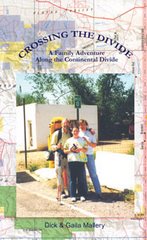
The first part of September, northbound CDT hikers begin showing up in Glacier National Park to finish an incredible journey that has taken them months of hiking along the rocky spine of North America. They are feeling euphoric. They have hiked to Glacier from the U.S. border with Mexico. The weather is usually perfect in Glacier the first part of September, and the hordes of tourist have left for the season.
I remember several casual conversations with people I ran into during the five days it took me to hike through Glacier at the end of my CDT hike. Near the end of the trek it was always worth a laugh when explaining to people that I started in Mexico.
I ran into a guided group returning from Grinnell Glacier. Telling them about my hike I mentioned Andy, Laura and Leslie (the three other Northbound hikers in 1999) also in the vicinity. When I said I hadn’t seen the girls since Colorado and that I had only hiked with Andy for 500 miles, they all thought that was hilarious. Yelling things like, "SINCE COLORADO!—500 MILES!"
Another humorous incident took place hiking through the Many Glacier Lodge area. It was almost dark and a woman sitting out on the balcony of her hotel asked me where I was headed. I told her I was going down the road to the Swiftcurrent campground. She said, "That’s a long way and it’s getting dark."
I said, "It’s only about a mile."
"Where are you coming from," she inquired.
"Mexico," I replied. "I started in April and hiked the Continental Divide."
She almost fell out of her chair.
"Where are you coming from," she inquired.
"Mexico," I replied. "I started in April and hiked the Continental Divide."
She almost fell out of her chair.
Once you reach Glacier you can choose several routes through the park to finish your hike. I used what I assume is the default route. For me it was a five day easy hike. With 3,000 miles under my belt I felt bullet-proof. Long mileage days were enjoyable in the perfect Indian Summer weather I was gifted with.
Some Choices (in my opinion)
Once you exit "The Bob" you cross Hwy. 2 at Marias Pass. You will see CDT signs if you cross the road and the RR tracks and look along the tree line. My five days took me first to Two Medicine where I picked up a hiking permit, then Red Eagle Lake, Swiftcurrent, Granite Park, Fifty Mtn. and out at Waterton townsite. The first half of the first day from Marias Pass to the town of East Glacier is boring. You end up hiking through thick vegetation that is not used often. It is not the kind of trails people travel to Glacier to explore. It is a necessary link to the park proper. From East Glacier to Canada you are on some of the premiere hiking tread in the world. Well worth the price of admission.
My suggestion would be not to exit the park at Chief Mountain unless that is logistically better for you because of transportation or scheduling reasons. Going to Goat Haunt and crossing the border into Waterton is so spectacular and uplifting.
Other route choices: a. Instead of going up to historic Granite Park from Swiftcurrent, go north through the Ptarmigan Tunnel and follow the valley up and over Stoney Indian Pass. This is another spectacular route.
b. If you want to stay closer to the Divide proper you can head west from Two Medicine, through the Nyack to Sperry and then take the Floral Park route across to Logan Pass, the Highline Trail to Granite Park and on to Goat Haunt. This is awesome terrain, but needs more respect than it gets. You are not a novice hiker if you have come this far but Floral Park is not a trail, it is only a route. You should be familiar with this route before you tackle it.
Backpacker Magazine did a short story on this route a couple years ago making it sound like a day hike in the alpine that anyone can pull off. No so. An example would be A hiker named, Yi-Jien Hwa, who attempted it this fall and has not been found yet. Thousands of hours of search and rescue with hundreds of volunteers have turned up no sign of him.
I'm not trying to scare anyone from using this route I am just making a point. Wilderness can be unforgiving if you are not prepared, and sometimes even if you are.
If you are as thankful as I am about the many wilderness areas that have been protected by forward thinking individuals in our short history, you will be interested in watching for this documentary set for release next year:
"The National Parks: America's Best Idea" is to air in autumn 2009 on PBS. This will be a six- part, 12 hour series produced by Ken Burns, a name we all equate with quality film.
One of the country's most startling innovations, Burns says, was the creation of a national park system in the late 19th and early 20th centuries.
"For the first time in human history, land was set aside not for the pleasure of kings and noblemen and the very, very rich, but for everybody, for all time."
With the parks project, he says, he wants to explore the movement that set aside Yellowstone and Yosemite and created the national park system. These seem like astonishing, out-of-character moves, he says, "in a culture so dedicated to the almighty dollar, so dedicated to a kind of extractive and acquisitive mentality. So how did this happen? Who were these people?"
These areas continue to be threatened by all of us--all of our needs, wants and desires. Let's pray we make the wise decisions that have protected these areas in the past and have preserved them for our generation. Let's hope we can continue to pass them along to a respectful upcoming generation of conservationist. --Keep Smilin', Dick E. Bird












No comments:
Post a Comment